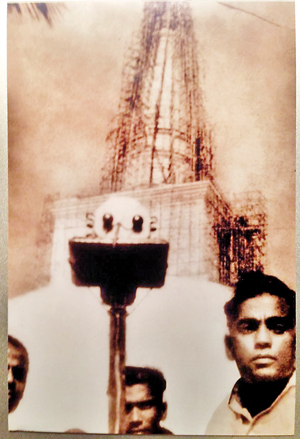The saga of the Burmese Chudamanikkaya

The Ruwanweli Seya in 1940 with H. Sri Nissanka standing on a platform near the Devatha Kotuwa ready to deliver his speech
At a ceremony in Anuradhapura on November 26 organised by the Ruwanweli Chetiyaramadhipathi Ven. Pallegama Hemarathana Nayaka Thera, the old ‘Chudamanikya’of the Mahaseya was replaced. The new crest gem on the pinnacle with a gold base on the Ruwanwelimahaseya was unveiled at the auspicious time of 10 a.m. The Most Ven. Mahanayake and Anunayake Theras representing the Siam, Amarapura and Ramanggna Nikayas were present.
This pristine white dagoba, stupa, thupa or chaitya is also known as Swarnamali Mahaceti, Mahathupa, Ratnamali Dagaba and Swarnamali Chaitya.
The following is the gatha (stanza) to venerate the Ruwanweli Maha Seya:
‘Sain Su Yasmin Sugathassa Dhathu
Nimmaya Ran Sujjala Buddha Rupam
Swarnamalithi Pathitha Namam
Wandha Maham Thupa Waram Mahaggam’
This stanza can be understood to mean “I venerate the thupa which has the Buddha’s relics and the golden Buddha image therein.” It is believed that the largest collection, a drona (two quarts) of Buddha’s relics (sarwanggnasharirikadhatu) is placed in Ruwanweliseya.
In 1940, the Ruwanweli Maha Chaityawardhana Society was faced with the task of renovating the Mahaseya and finding a Chudamanikkya to be placed on the kotha (pinnacle). As it was not available in Ceylon, they obtained the help of the Burmese monk, the Most Ven. U.Vinayanlankara Thera, the incumbent Maha Thera of the Dematagoda Makutarama in Colombo. The monk sailed to Burma in 1933 and brought a crystal but the craftsmen here were unable to craft such a large stone. It was taken back to Burma but when it was being cut and shaped, they found a flaw and decided it was unsuitable. The mine owners in Amarapura in northern Burma gifted a second and bigger crystal to the monk from the famous gem mines in the city of Mogok, which was cut and shaped to be placed on the pinnacle as the Chudamanikkya on the Ruwanweliseya.
On June 17, 1940, the Chudamanikkaya was placed on the renovated Ruwanweliseya at 8.50 a.m. by the Burmese monk, Ven. U. Vinayalankara Thera, Ven. Baddegama Sri Piyarathana Thera, representatives of the Ruwanweli Maha Chaityawardhana Society D. Wanigasekera, C.R. Wettewewa and B. Steven Perera. A programme titled ‘Mahaseye Abhisheka Mangalya’ covering the period June 15 to July 19, 1940 was issued on June 1, 1940 by the Ruwanweli Maha Chaityawardhana Samitiya, giving details of the ceremonies to be conducted during that period. A copy of this is preserved by Avanti Sri Nissanka Karunaratne, as her grandfather H. Sri Nissanka had participated in the ceremonies.
Three eminent Sri Lankans, Sir D.B. Jayatillake, Dr.G.P. Malalasekera and H. Sri Nissanka were speakers at these ceremonies. On June 15, H. Sri Nissanka, a prominent Advocate spoke on the subject, “Maha Chaitye abhisheka mangalyanubhavayen lokasamaya selaseva.” His speech was recorded by the BBC. There were other dignitaries who participated in the pirith chanting and other ceremonies throughout this period of religious activities.
Today, a UNESCO World Heritage Site, Anuradhapura is the first Royal capital of this island. It is documented that King Pandukabhaya is the founder of the city. It is now known as the Anuradhapura Pooja Nagaraya, the Sacred City.
With the kings’ patronage, Buddhism was made a way of life for centuries. Buddhist monuments, images, stupas also known as dagaba, Seya or chaitya were built with bricks in the outer city. The royal palace was in the inner city. The tallest of the stupas are Jetawana, Abhayagiri and Ruvanweliseya in Anuradhapura. These constructions are considered marvels of architecture
The Ruwanweliseya is a hemispherical stupa built by King Dutugemunu who died before its completion. When he was ill, the king requested his brother Saddha Tissa to complete the construction. Ruwanweliseya which was venerated by the ancient kings and the people was maintained over the centuries, but was neglected with the invasion of the Portuguese, Dutch and the British. People were unable to access the stupa which was engulfed by thick jungle and seen only as a heap of bricks overgrown with grass. It was Ven. Naranwita Sumanasara Thera who went in search of Ruwanweliseya in 1873 and seeing its state, decided to restore it to its former glory. Once he started the work, people came to his assistance. Later, the Anuradhapura Ruwanweli Maha Chaitya Development Society was formed in 1912 to continue the maintenance of the seya.


